1. Current account deficit contracted. Exports remained sluggish compared to the top years
The current account remained in deficit in 2014 regardless of the surplus in goods trade and the primary income account. Exports remained sluggish compared to the top years in exports. Goods imports in balance of payment terms continued to fall. The financial account showed net capital inflow. Finland's net international investment position went down.
1.1. Current account
In 2014, the current account was EUR 1.8 billion in deficit. The deficit was a result of the services account and the secondary income account being in deficit. The deficit of the services account was EUR 1.8 billion and that of the secondary income account EUR 2.4 billion. Goods trade was EUR 1.3 billion in surplus and the primary income account EUR 1.1 billion in surplus.
Figure 1. Current account balances, 2006–2014, EUR billion
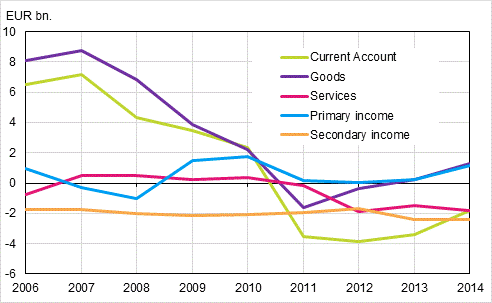
Compared to the year before, the current account deficit decreased. This was because the surpluses of goods trade and the primary income account grew. The current account credits increased by 1,6 per cent from the previous year, which was primarily influenced by the primary income account. The current account debits remained on level with the previous year.
Figure 2: Current account by sub-item, credits and debits, 2006–2014, EUR billion
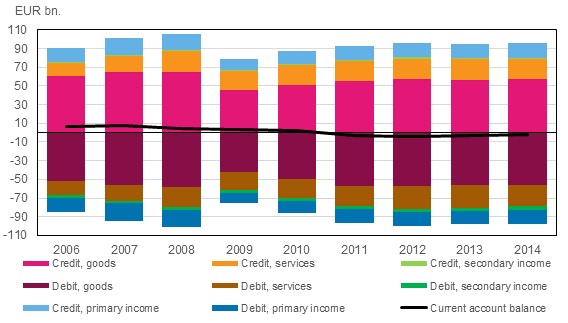
1.1.1 Goods trade
Goods exports in balance of payment terms amounted to EUR 57.2 billion in 2014 and imports to EUR 55.9 billion, which means that the goods account was in surplus. Exports of goods trade grew by 0.7 per cent from goods exports in 2013, while imports went down by 1.2 per cent. From 2008, goods exports in balance of payments terms have fallen by as much as 12 per cent and goods imports in balance of payments terms by four per cent.
Figure 3: Export and Import of Goods, 2006-2014, EUR billion
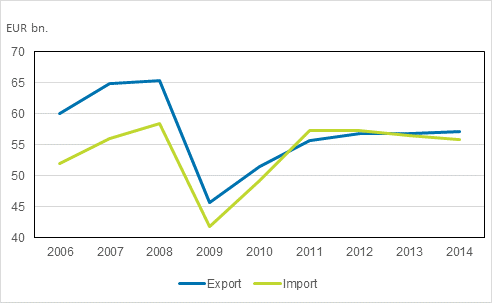
1.1.2 Services
Finland's services account was EUR 1.8 billion in deficit as exports of services amounted to EUR 21.2 billion and imports to EUR 23.0 billion. The biggest single item in service exports was telecommunication, data processing and information services, which accounted for one-third of total exports of services. Other key items in service exports were other business services and travel. The most significant items in service imports were other business services, transportation and travel.
Both, service exports and imports declined from 2013 level, service exports by 4,9 per cent and imports by 3 per cent. Exports of services declined nearly in all service categories. There was growth in the category of telecommunication, computer and information services, whose exports grew by as much as 27 per cent from the year before. Imports of services grew most in manufacturing on physical inputs owned by others, and fell in the items of construction and other services.
Figure 4: Items of service exports in 2014
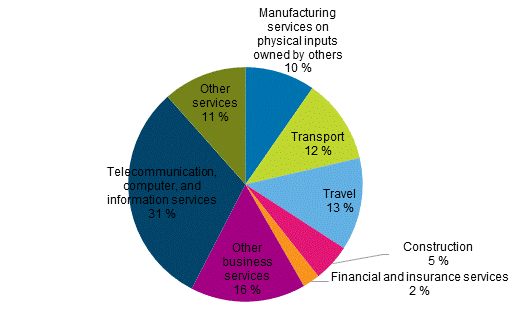
Travel income in 2014 amounted to EUR 2.7 billion and travel expenditure to EUR 4.0 billion, for which reason the travel account was as much as EUR 1.3 billion in deficit. Travel income went down by 11 per cent year-on-year and travel expenditure remained on level with the previous year. The decline in travel income was caused by the fallen consumption by Russian tourists in Finland. Travel expenditure has increased steadily from 2006 onwards. Travel expenditure to Spain, Sweden and the United States grew from the year before – while travel expenditure spent on travelling to Estonia went down from a year ago.
Figure 5: Travel expenditure on travel from Finland abroad in 2010–2014, EUR million
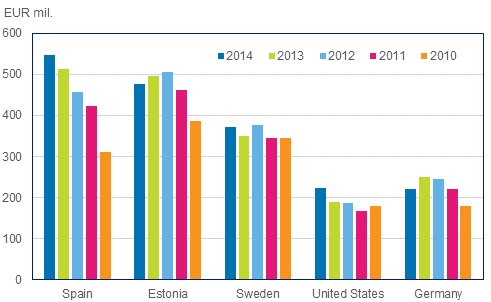
1.1.3 Exports by country
The most significant countries for exports of goods and services are Sweden, Germany and Russia. Sweden was clearly the biggest trade partner for goods and services. In 2014, the value of the combined goods and service exports to Sweden was EUR 9.9 billion (goods exports EUR 6.9 billion and service exports EUR 2.9 billion). The exports distribution by country has changed from 2013 in that Germany has become the second biggest exporting country, while in 2013 Russia was Finland's second biggest trade partner. The combined exports of goods and services to Russia went down by 17 per cent from 2013. In turn, the combined exports of goods and services to Germany went up by 21 per cent. The growth came from increased exports of goods trade, because service exports to Germany slowed down slightly.
Figure 6: Goods and services, export by country 2014, EUR billion
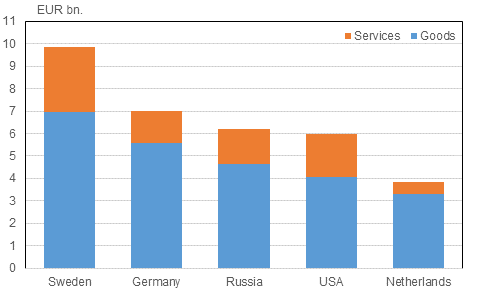
Imports from Russia have in recent years been clearly larger than exports. From 2008, the combined exports of goods and services to Russia has fallen by 34 per cent and imports by 17 per cent. As Russian trade has slowed down, the combined imports of goods and services from Russia went down by EUR 1.9 billion compared to the year before, while imports declined by EUR 1.2 billion. The deficit in Russian trade in 2014 thus falls from EUR 3.2 billion in 2013 to EUR 2.5 billion.
Figure 7: The combined trade of goods and services with Russia, 2006-2014, EUR billion.
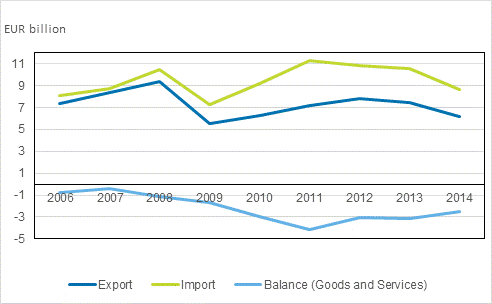
1.1.4 Primary income and secondary income
With EUR 16.4 billion primary income earnings to Finland in 2014 and EUR 15.2 billion paid to non-residents, the primary income account showed a surplus of EUR 1.1 billion. The surplus of the primary income account was highest in four years. Both primary income to Finland and those paid to non-residents grew from 2013.
The primary income account is comprised of compensations of employees, investment income and other primary income. The most significant item of these is investment income, of which EUR 0.7 billion in net were paid to Finland. In 2014, investment income paid to Finland amounted to EUR 14.9 billion, of which dividend income was EUR 9.2 billion, which is clearly more than in the previous years. Interest income paid to Finland remained, in turn, on level with the previous years, as interest income totalled EUR 4.7 billion.
Investment income paid abroad from Finland totalled EUR 14.2 billion. EUR 8.5 billion of the investment income paid abroad from Finland were dividend expenditure and EUR seven billion interest expenditure. The interest payments on portfolio investments in net were EUR –1.2 billion. The key sectors in the investment income of primary income were financial institutions and non-financial corporations.
1.1.5. Revision of the current account and conceptual corrections
Time series corrections have been carried out in the manufacturing services on physical inputs owned by others for the years 2013 and 2014, thus impacting the exports and imports of services and goods trade. These corrections are part of the implementation of the BPM6, adopted in 2014. These corrections increased the imports and exports of goods trade for 2013 and 2014.
1.2 Financial account and international investment position
Inward capital flow on net to Finland was EUR 8.4 billion, that is, the investment flow from abroad to Finland was greater than investments from Finland to abroad. Finland's net international investment position was EUR 8.2 billion negative at the end of 2014, having been EUR 7.1 billion positive one year earlier. The net international investment position describes the difference between foreign assets and liabilities. The foreign net assets of 2013 had turned into net liabilities during 2014. Finland's net international investment position has been falling since 2010. Exchange rate and other valuation changes also lowered the net international investment position by EUR 5.0 billion. At the end of 2014, foreign assets amounted to EUR 718.9 billion and foreign liabilities to EUR 727.1 billion.
Figure 8: Financial account 2006-2014, EUR billion
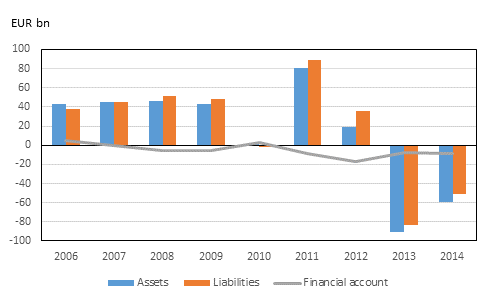
1.2.1 Financial account and international investment position by sector
The other monetary financial institutions sector had the most foreign assets and liabilities at the end of 2014. At the end of the year, other monetary financial institutions, such as banks and other credit institutions, had EUR 291.5 billion in foreign assets and EUR 363.0 in liabilities. The net liabilities in this sector increased mainly due to deposit liabilities but also because of liabilities connected to direct investments and securities. The growth in loans receivable, in turn, particularly decreased net liabilities.
The central bank's net assets remained at the previous year's level, at EUR 34.5 billion. Portfolio investment assets and reserve assets grew slightly, while deposit assets belonging to other investments decreased.
Figure 9: Net international investment position by sector in 2006 to 2014, EUR billion
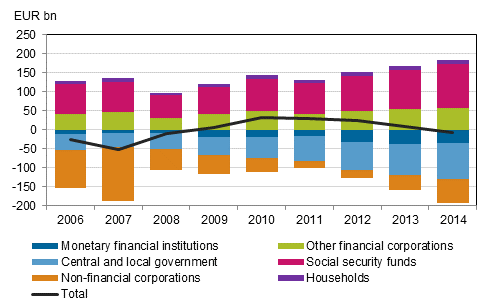
Non-financial corporations' foreign assets fell somewhat while liabilities continued to grow, resulting in a growth of EUR 20.0 billion in non-financial corporations' foreign net debt. At the end of the year, net debt amounted to EUR 61.6 billion while assets were EUR 120.9 billion and liabilities EUR 182.6 billion. The growth in foreign direct investment (FDI) liabilities had the biggest effect on net debt, but equity liabilities abroad also grew considerably.
The central government's foreign gross debt in balance of payment amounted to EUR 111.8 billion at the end of 2014, having been EUR 97.5 billion one year earlier. The growth of debt was mainly caused by an increase in bonds. The central government's foreign assets amounted to EUR 18.7 billion at the end of the year. The net international investment position of social security funds continued to grow during 2014, being EUR 116.0 billion at the end of the year, while the net investment position was EUR 101.6 billion at the end of 2013. Social security funds increased their investments in shares and mutual fund shares.
1.2.2 Finland's outward portfolio investments
The net flow of Finland's outward investments directed to foreign securities, that is, the difference between sales and purchases totalled EUR 13.5 billion in 2014. EUR 1.7 billion were invested in foreign shares, which was EUR 2.9 billion less than in 2013. Shares in mutual funds registered abroad were purchased to the value of EUR 2.1 billion, which was somewhat less than in the year before. In contrast, investments in long-term bonds grew considerably compared to the previous year, as the investment flow was EUR 8.5 billion in 2014.
Other monetary financial institutions had the highest capital outflow and their investments in foreign securities grew by EUR 7.6 billion. They increased their foreign investments particularly in bonds and money market instruments. Social security funds (particularly employment pension schemes) increased their foreign investments by EUR 3.9 billion, most of which were investments in mutual fund shares. Mutual funds registered in Finland invested EUR 3.8 billion in foreign securities.
Figure 10: Stocks of outward portfolio investments in 2014 by investor sector, EUR billion
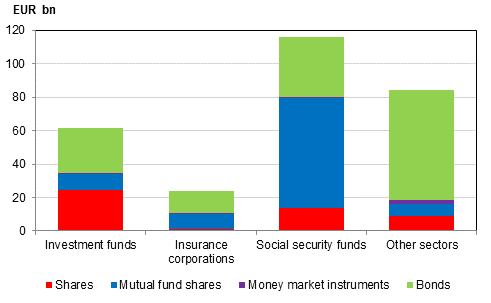
The market value of Finland's outward portfolio investments was EUR 286.1 billion at the end of 2014. Price changes have a significant effect on the value of the investment stock and they increased the market value of portfolio investments by EUR 11.4 billion during 2014. Correspondingly, portfolio investments grew by EUR 8.9 billion in the previous year because of price changes. Price changes raised the value of shares and mutual fund shares by 6.8 per cent, while, at the same time, the comparison indices rose by 2.9 per cent (MSCI World Index) and by 11.4 per cent (S&P500 Index). Exchange rate changes also raised the market value of portfolio investments by EUR 6.8 billion.
Figure 11: Annual change of outward portfolio investments in 2006 to 2014, EUR billion
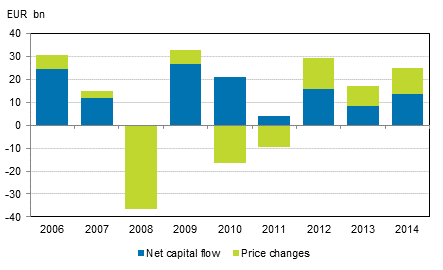
Altogether, EUR 6.1 billion were paid as profits related to outward portfolio investments. Dividend income from abroad to Finland amounted to EUR 1.3 billion, while one year before, the corresponding figure was EUR 1.2 billion. Interest income paid from abroad to Finland was unchanged from the year before, that is, EUR 3.6 billion.
1.2.3 Inward portfolio investments
Portfolio investment liabilities grew in total by EUR 27.7 billion in 2014. EUR 8.9 billion of this are explained by foreign investors' new investments in Finnish securities and the rest, EUR 18.8 billion, by the rise in the value of securities. Compared with 2013, the investment flow to Finland contracted.
Figure 12: Finnish non-financial corporations' portfolio investment liabilities, investment flows in 2006 to 2014, EUR billion
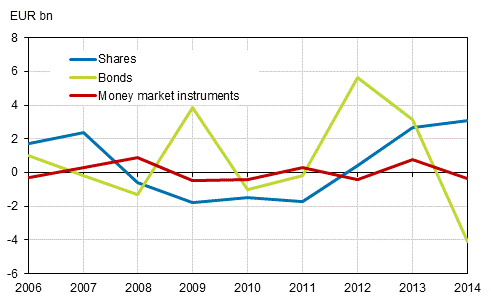
Non-financial corporations' portfolio investment liabilities grew in total by EUR 3.3 billion from EUR 74.0 billion to EUR 77.3 billion. Foreign investors used EUR 3.1 billion to purchase Finnish non-financial corporations' shares, while one year before, EUR 2.6 billion in net were invested in the shares of Finnish non-financial corporations from abroad. During 2014, the value of Finnish non-financial corporations' shares also grew, which increased the investment stock. Price changes increased the share liabilities of non-financial corporations by 4.1 per cent compared to the stock of investments at the end of 2013, while, at the same time, the comparison index (OMX Helsinki CAP) rose by 5.7 per cent. Foreign investors decreased their investments in bonds issued by non-financial corporations by over EUR four billion, while one year earlier, investments increased by over EUR three billion.
The majority of non-financial corporations' portfolio investment liabilities, nearly 80 per cent, was foreigners' investments in shares. Foreign investments directed to non-financial corporations' bonds made up under 20 per cent of the portfolio investment liabilities.
Figure 13: Finnish non-financial corporations' portfolio investment liabilities, investment stocks in 2006 to 2014, EUR billion
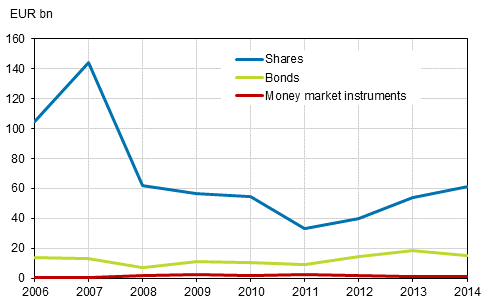
In 2014, dividends paid to foreign investors on portfolio investments in Finland totalled EUR 2.9 billion, while one year before, dividends paid to foreign investors were EUR 0.8 billion lower. Only slightly more interests were paid abroad from Finland than in the previous year, that is, EUR 4.9 billion.
1.2.4 Direct investments
In this publication, foreign direct investments are examined in gross amounts. This means that intra-group foreign liabilities and debts included in direct investments are not netted in any respect. At the end of 2014, direct investment assets on gross stood at EUR 127.6 billion and corresponding liabilities at EUR 108.4 billion. During 2014, assets decreased by EUR 7.8 billion, while liabilities grew by EUR 13.2 billion. In assets, both equity and debt-based investments diminished, while liabilities grew in both items. Examined in gross, direct investment assets continued the fall that started in the year before. Before that, the stock of assets grew strongly for several years. In 2014, liabilities grew by EUR 13.2 billion while one year earlier liabilities contracted by EUR 8.7 billion. As a result of contracting assets and growth of liabilities, net assets connected to direct investments halved in 2014 to EUR 19.3 billion compared to EUR 40.3 billion in the year before.
Figure 14: Direct investment assets and liabilities on gross in 2006 to 2014, EUR billion
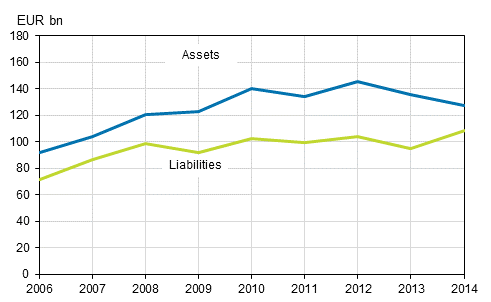
In 2014, Finland's returns on inward FDI amounted to EUR 8.5 billion, that is, clearly more than in the previous year (EUR 6.3 billion). Slightly more returns from outward FDI were recorded than in the year before, EUR 4.9 billion (2013: EUR 4.5 billion). Relative to the gross assets and liabilities at the end of 2014, the returns on assets invested abroad from Finland were 6.7 per cent and of outward FDI 4.5 per cent, while the corresponding figures were 4.3 and 4.8 per cent in 2013.
Figure 15: Profits received and paid on direct investments in 2006 to 2014, EUR billion
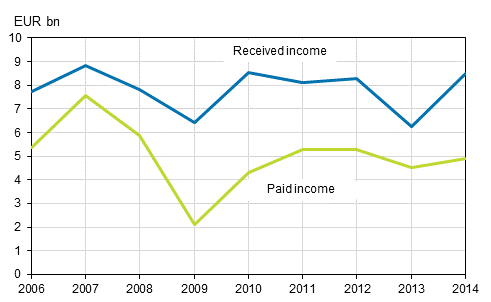
Primarily, the non-financial corporations and financial corporations sectors have direct investments. The sector is determined based on the sector of the domestic party of the investment relationship. In 2014, the non-financial corporations sector accounted for 78 per cent of FDI liabilities and the financial sector for 21 per cent. The non-financial corporations sector held the share of 87 per cent and the financial sector 11 per cent of FDI claims.
Figure 16: Direct investment assets on gross in 2014, (shares by sector)
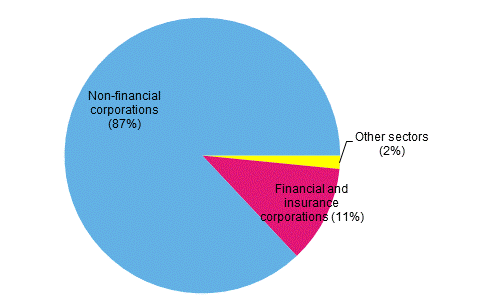
1.2.5 Derivatives and other investments
At the end of 2014, Finns had EUR 129.2 billion in assets related to derivatives and EUR 121.7 billion in liabilities. Most of the assets and liabilities related to derivatives are held by banks. From the end of 2013, assets have grown by EUR 43.9 billion and liabilities by EUR 41.4 billion.
Other investments in the financial account include loans, deposits, trade credits and other equity. Other equity consists of equity that is not in the form of securities and that comprises holdings in international organisations, branches and other units without a separate legal identity. In this category, Finns' assets were EUR 167.3 billion and liabilities EUR 205.4 billion at the end of 2014, most of which are held by the central bank, other banks and non-financial corporations.
At the end of 2014, Finns' deposit assets amounted to EUR 77.6 billion and liabilities to EUR 155.0 billion. Loan assets amounted to EUR 66.5 billion and liabilities to EUR 27.8 billion.
Source: Balance of payments and international investment position, Statistics Finland
Inquiries: Mira Malhotra 029 551 3411, Tapio Kuusisto 029 551 3318, balanceofpayments@stat.fi.
Director in charge: Ville Vertanen
Updated 30.9.2015
Official Statistics of Finland (OSF):
Balance of payments and international investment position [e-publication].
ISSN=2342-348X. 2014,
1. Current account deficit contracted. Exports remained sluggish compared to the top years
. Helsinki: Statistics Finland [referred: 19.4.2025].
Access method: http://stat.fi/til/mata/2014/mata_2014_2015-09-30_kat_001_en.html

